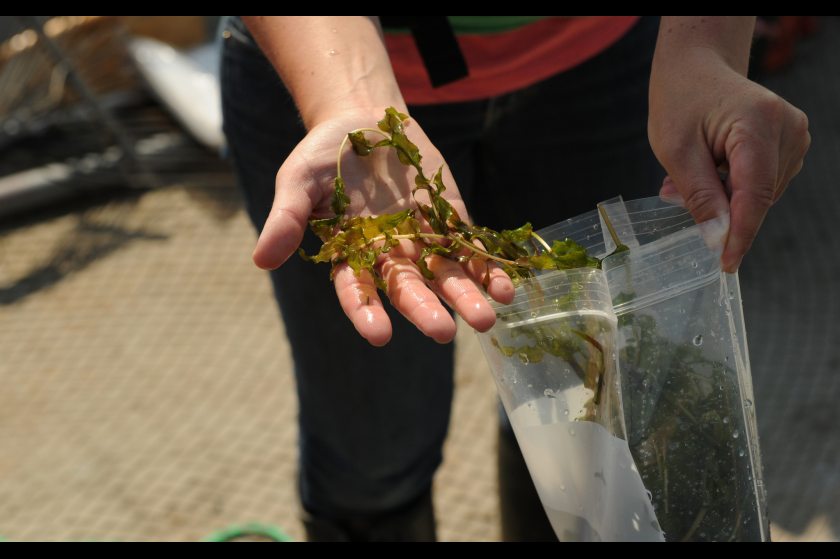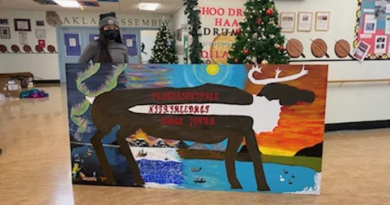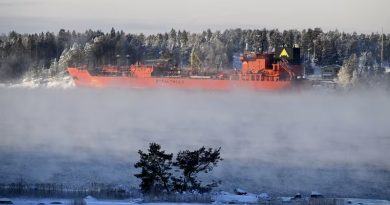Alaska: Invasive plant found in floatplane lake

A tenacious, invasive aquatic plant is now growing in what might be the worst place in Alaska – the floatplane mecca of Lake Hood.
The site – actually two connected lakes in West Anchorage, part of the Anchorage international airport complex – has long been touted as the world’s busiest floatplane center. Now it could be the vector for the spread of elodea, a leafy, long-stemmed plant notorious for crowding out native species of freshwater flora.
Elodea, a plant much used in freshwater aquariums, has already taken hold in several sites in Alaska. It was first found in Cordova’s Eyak Lake in 1982 and has since spread to sites from Fairbanks to the Kenai Peninsula.
The bad news about Lake Hood came when Amy Larsen, a plant specialist with the National Park Service, found some of it growing near the U.S. Fish Wildlife Service aircraft area, said Heather Stewart, a state invasive-species expert.
Could be spread by planes
For elodea in Alaska, Lake Hood is “the worst place but, to be honest, not unexpected,” said Stewart, invasive weeds and agricultural pest coordinator for the Alaska Department of Natural Resources. Stewart spent much of sunny Wednesday afternoon traveling by boat on Lake Hood and connecting Lake Spenard, probing the plants growing beneath the gently lapping waves.
The Lake Hood Seaplane Base is home to about 500 aircraft, said John Parrott, manager of Ted Stevens Anchorage International Airport. Traffic volumes vary by season, but in summer there can be hundreds of takeoffs and landings daily, he said.
The discovery of elodea there means any of those departing planes could bring elodea to new sites within a radius of a few hundred miles.
DNR had already been poised to start eradicating elodea this summer from the three Anchorage lakes where it has been established for years – Little Campbell Lake, Sand Lake and DeLong Lake. The project involves applications of the herbicide fluridone, in concentrations low enough to minimize damage to native plants and other resources, officials say. It is not a quick fix; the project is planned to run through 2017.
Now that Lake Hood has elodea, could it be added to the list of Anchorage lakes scheduled for treatment?
“That’s what we’re investigating how to do,” Stewart said. “Ideally, we would like to do it at the same time period as the other lakes. Realistically, is that going to happen? Maybe not.”
Emergency designation?
DNR may be able to get some kind of official emergency designation for the Lake Hood elodea, she said. But adding Lake Hood to the Anchorage project won’t be instantaneous, she warns.
Since the eradication projects planned for Little Campbell, Sand and DeLong lakes are funded by a federal agency – the Fish and Wildlife Service – they must go through a formal process under the National Environmental Policy Act. Adding Lake Hood to the list, if work there is to be federally funded, would require a supplemental environmental assessment, a process involving a 30-day public comment period, Stewart said.
The elodea eradication project, as planned by DNR, also requires a herbicide permit from the Alaska Department of Environmental Conservation’s Pesticide Control Program, a process that usually takes at least 90 days, Stewart said. To add Lake Hood to the Anchorage project would require resubmission of the permit application.
Action at Lake Hood could be hastened if the state or municipal governments provided the funding, thereby avoiding the federal NEPA process, she said. And a provision in the state’s pesticide-permit regulations allows for emergency authorizations, she said.
Evaluating responses
Another quick-action response might be to smother the plants with a blanket-like covering, a technique that can work if the infestation is very small, said Stewart and Gino Graziano, an invasive species instructor with the University of Alaska Fairbanks Cooperative Extension Service.
The origins of Alaska’s elodea are unknown, but aquarium owners are among the suspects. Since elodea, with its translucent leaves, is a popular subject for school science studies, it is also possible the spread originated from a science project, Stewart and Graziano said.
Two species of elodea have infested Alaska: Elodea canadensis and Elodea nuttallii, which are nearly identical in appearance, Graziano said. “You can’t really tell the difference until they flower,” he said. The hope is to remove the plants before they get to that point and are starting to spread seeds, he said.
Alaska is far from alone in its battle against elodea. The plant, which is native to North and South America, has invaded freshwater bodies in northern Europe and in Russia. Perhaps most famously, it became established in the late 1970s in Russia’s Lake Baikal, the world’s deepest freshwater lake, and has changed the ecosystem there, according to a study from the Russian Academy of Sciences.
While state officials are trying to determine the extent of the Lake Hood infestation and the best ways to respond to it, they are also focusing on spreading the words of warning. There are steps that floatplane pilots can take to minimize the risk of spreading invasive species; large ships and small boats, road vehicles and even footwear are among other common vectors for which precautionary measures can be taken.
A notice about the discovery of elodea, sent last week by airport managers to local aviators, confirmed long-held fears of Scott Christy, president of the Lake Hood Pilots Association.
Contingency plan needed
For years, he said, he has been urging the airport to establish what would be, in effect, a contingency plan for eradicating elodea as soon as it appears in Lake Hood. He has been frustrated by what he considers an unenthusiastic response, he said.
“My solution is to hit it now, hit it hard and kill it. Don’t fart around,” Christy said. It is very dangerous in any floatplane area, he said. “It gets caught in your water rudders and you don’t even see it,” he said.
Four years ago, he urged airport managers to take a specific and drastic approach – douse Lake Hood with a powerful chemical to make it “a vegetation dead zone.”
Parrott, for one, has not been receptive to that idea.
“It’s not as simple as it may seem,” he said. “We don’t simply run down to Walmart and buy several tubs of some herbicide and dump it in the lake.”
And, despite the significance of Lake Hood, dealing with elodea and floatplanes cannot be a one-lake project, Parrott said. “Once it’s in a lake, eradication of it in that single lake doesn’t solve the problem,” he said. As long as elodea exists elsewhere in the region, it could be carried into Lake Hood, he said.
The Lake Hood elodea discovery, though unfortunate, is in one sense fortuitously timed. Last Sunday kicked off what has been designated Invasive Species Awareness Week, as declared in a proclamation by Gov. Bill Walker.
Related stories from around the North:
Canada: Study shows polar bears relocating to icier Canadian Archipelago, Alaska Dispatch News
Finland: Climate change affecting Finland’s Arctic hares, Yle News
Sweden: Sweden’s mountain hares changing fur color too early, Radio Sweden
United States: Rock snot is no Alaska invader, but it’s spreading fast as climate warms, Alaska Dispatch News



